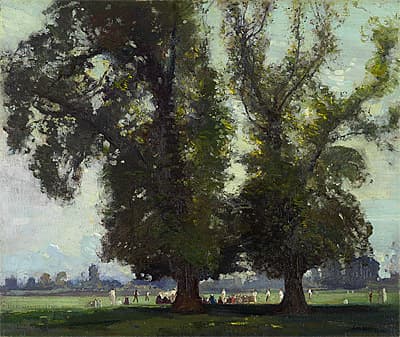
Sydney
LONG
Australia
1871
–
London
1955
England, Europe 1910-21; Australia 1921- 22; England 1922-25; Australia 1925-52; England from 1952
68.8 (h) x 81.5 (w) cm
signed and dated ‘SID LONG/ 1924’ lower right National Gallery of Victoria, Melbourne, Felton Bequest 1927
‘Now in Maytime to the wicket/ Out I march with bat and pad:/ See the son of grief at cricket/ Trying to be glad’, wrote A.E. Housman in his group of poems ‘A Shropshire lad’, published in 1896.
Long certainly enjoyed cricket and claimed it was his favourite recreation. He also suggested that he was 'the inaugurator of an Artists’ Cricket Club’, a club that ‘often challenges the journalists, and prides itself on having gained the larger number of wins’ (Red Funnel, 1 November 1906).
In Cricket match on the green, Long depicted a small group of cricket enthusiasts and players. But the trees in the foreground, with their branches twisting and turning, dominate the scene and frame the action.
The location is most likely Mitcham Cricket Green in south-west London in the Borough of Merton. In 1955, when Catherine Long wrote to Adolph Albers informing him of Long’s death, she observed that Sid was to be buried at Streatham cemetery, ‘near Mitcham and the Wandle where he used
to sketch and paint’ (Catherine Long, 25 January 1955).
Mitcham Cricket Green is reportedly the oldest cricket ground still in use in England, having been the venue for matches since 1685. In the 19th century, while on tour, the Australian cricket team used to stay at The Cricketers pub overlooking the green, and practised on the grounds.
Cricket match on the green was first shown in 1926 at the ‘Royal Art Society of NSW exhibition’, Sydney (23).
‘Now in Maytime to the wicket/ Out I march with bat and pad:/ See the son of grief at cricket/ Trying to be glad’, wrote A.E. Housman in his group of poems ‘A Shropshire lad’, published in 1896.
Long certainly enjoyed cricket and claimed it was his favourite recreation. He also suggested that he was 'the inaugurator of an Artists’ Cricket Club’, a club that ‘often challenges the journalists, and prides itself on having gained the larger number of wins’ (Red Funnel, 1 November 1906).
In Cricket match on the green, Long depicted a small group of cricket enthusiasts and players. But the trees in the foreground, with their branches twisting and turning, dominate the scene and frame the action.
The location is most likely Mitcham Cricket Green in south-west London in the Borough of Merton. In 1955, when Catherine Long wrote to Adolph Albers informing him of Long’s death, she observed that Sid was to be buried at Streatham cemetery, ‘near Mitcham and the Wandle where he used
to sketch and paint’ (Catherine Long, 25 January 1955).
Mitcham Cricket Green is reportedly the oldest cricket ground still in use in England, having been the venue for matches since 1685. In the 19th century, while on tour, the Australian cricket team used to stay at The Cricketers pub overlooking the green, and practised on the grounds.
Cricket match on the green was first shown in 1926 at the ‘Royal Art Society of NSW exhibition’, Sydney (23).
‘Now in Maytime to the wicket/ Out I march with bat and pad:/ See the son of grief at cricket/ Trying to be glad’, wrote A.E. Housman in his group of poems ‘A Shropshire lad’, published in 1896.
Long certainly enjoyed cricket and claimed it was his favourite recreation. He also suggested that he was 'the inaugurator of an Artists’ Cricket Club’, a club that ‘often challenges the journalists, and prides itself on having gained the larger number of wins’ (Red Funnel, 1 November 1906).
In Cricket match on the green, Long depicted a small group of cricket enthusiasts and players. But the trees in the foreground, with their branches twisting and turning, dominate the scene and frame the action.
The location is most likely Mitcham Cricket Green in south-west London in the Borough of Merton. In 1955, when Catherine Long wrote to Adolph Albers informing him of Long’s death, she observed that Sid was to be buried at Streatham cemetery, ‘near Mitcham and the Wandle where he used
to sketch and paint’ (Catherine Long, 25 January 1955).
Mitcham Cricket Green is reportedly the oldest cricket ground still in use in England, having been the venue for matches since 1685. In the 19th century, while on tour, the Australian cricket team used to stay at The Cricketers pub overlooking the green, and practised on the grounds.
Cricket match on the green was first shown in 1926 at the ‘Royal Art Society of NSW exhibition’, Sydney (23).
